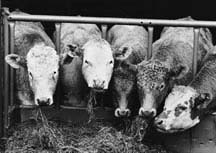Cows could foster flu pandemics

Cattle, like pigs and birds, may carry new flu strains. <br>© PhotoDisc <br>
Cattle join farmyard of potential influenza carriers.
Cattle could act as a breeding ground for future flu outbreaks. So say researchers tracking emerging strains in animals in the hope of averting further human pandemics.
Killing nearly half a million people worldwide, the last flu pandemic swept the globe in 1968. Flu viruses originate in wild birds and are thought to become lethal when they cross into poultry or pigs. In cells infected with another flu variety, the viruses pick up genes that enable them to infect humans.
Cows, too, could be harbouring new strains, a joint meeting of the European Society for Clinical Virology, the European Society for Veterinary Virology and the Society for General Microbiology heard in London today. Ian Brown and his colleagues at the Veterinary Laboratories Agency near Weybridge, UK, have detected influenza genes in cattle for the first time. „There may be different hosts out there,“ Brown warns.
Dormant cattle viruses could emerge in more virulent forms to infect humans, agrees flu researcher Alan Hay of the National Institute for Medical Research in London. It is not known where the cattle virus originated, nor whether it can spread from cow to cow.
Lethal variety
Each year, new predominant flu strains emerge through a shuffling of the proteins in the viral coat. Annual vaccines are targeted against this. But varieties that jump to humans directly from animals are so different that our innate immunity and current vaccines are useless.
Such killer strains strike every 30-40 years: „It’s now 34 years since the last pandemic; that’s why everyone is quite twitchy,“ says Brown.
The danger was highlighted in 1997, when six of 18 people infected were killed by a ’bird flu’ that crossed into humans in the poultry markets of Hong Kong. Unable to spread from person to person, this flu died with its victims – but another killer flu is expected to follow. „It could spread across the globe before a vaccine could be prepared,“ says Brown.
Viral surveillance
Most predict that the next pandemic will emerge in Southeast Asia, like the previous two. There, wild birds, poultry, pigs and people mix in the market-places. „Live poultry markets are the breeding ground of these viruses,“ says Robert Webster, director of the WHO Collaborating Center on the Ecology of Influenza Viruses in Lower Animals and Birds.
The tracking of animal viruses needs to be intensified, argues Webster: „It is still in its infancy.“
In efforts to thwart the next outbreak, Brown’s team have documented the genetic differences between numerous bird flu variants circulating around Europe and the Middle East; previous studies concentrated on Asia. Using this information, the group hope to pinpoint the origins of human viruses more accurately.
Ultimately, researchers want to identify the genetic changes that allow a virus to jump species, and to detect potential pandemics in time to prepare vaccines. Brown’s team contribute to the World Health Organization’s influenza surveillance network, FluNet, which monitors human and animal flu strains.
Media Contact
Alle Nachrichten aus der Kategorie: Medizin Gesundheit
Dieser Fachbereich fasst die Vielzahl der medizinischen Fachrichtungen aus dem Bereich der Humanmedizin zusammen.
Unter anderem finden Sie hier Berichte aus den Teilbereichen: Anästhesiologie, Anatomie, Chirurgie, Humangenetik, Hygiene und Umweltmedizin, Innere Medizin, Neurologie, Pharmakologie, Physiologie, Urologie oder Zahnmedizin.
Neueste Beiträge

Retinoblastom: Aufschlussreiche Untersuchung von Tumorzellen der Netzhaut
Ein Forschungsteam der Medizinischen Fakultät der Universität Duisburg-Essen und des Universitätsklinikums Essen hat ein neues Zellkulturmodell entwickelt, mit dem die Wechselwirkungen zwischen Tumorzellen und ihrer Umgebung beim Retinoblastom besser untersucht…

Eine gut erledigte Aufgabe: Wie Hiroshimas Grundwasserstrategie bei der Bewältigung von Überschwemmungen half
Grundwasser und multilaterale Zusammenarbeit in den Wiederaufbaubemühungen milderten die Wasserkrise nach der Überschwemmung. Katastrophen in Chancen umwandeln Die Gesellschaft ist oft anfällig für Katastrophen, aber wie Menschen während und nach…

Die Zukunft gestalten: DNA-Nanoroboter, die synthetische Zellen modifizieren können
Wissenschaftler der Universität Stuttgart haben es geschafft, die Struktur und Funktion biologischer Membranen mithilfe von „DNA-Origami“ zu kontrollieren. Das von ihnen entwickelte System könnte den Transport großer therapeutischer Lasten in…



